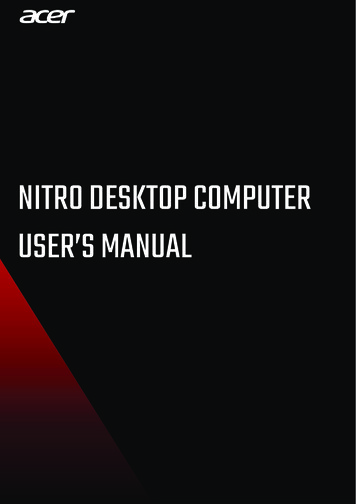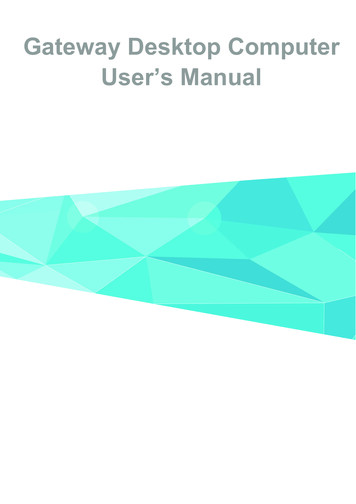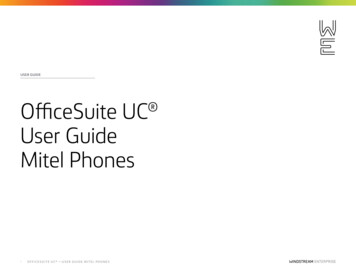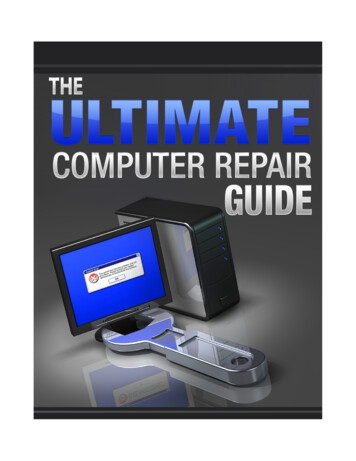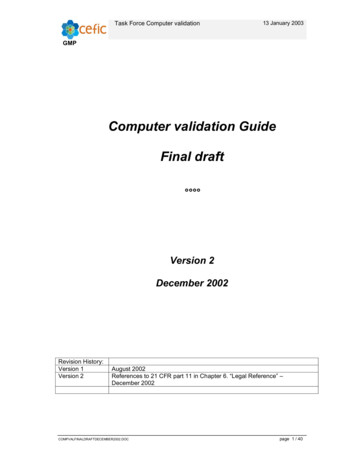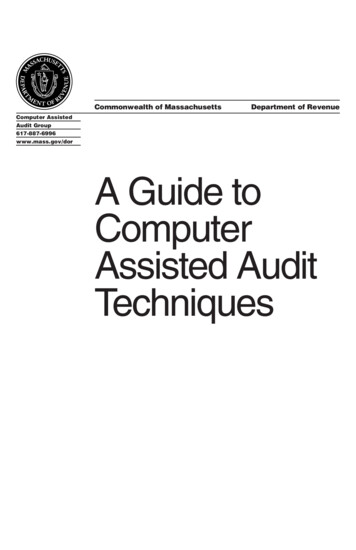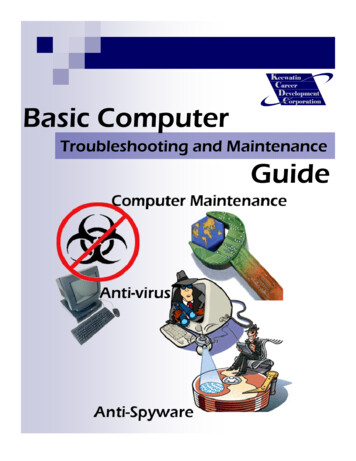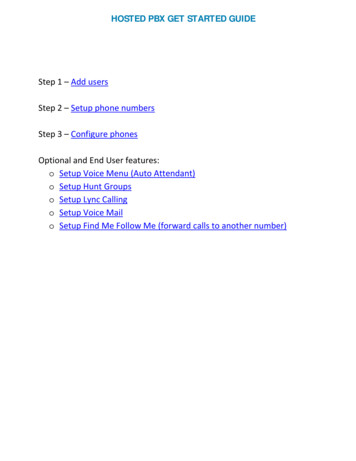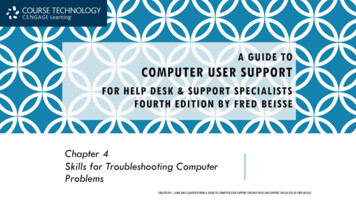
Transcription
A GUIDE TOCOMPUTER USER SUPPORTFOR HELP DESK & SUPPORT SPECIALISTSFOURTH EDITION BY FRED BEISSEChapter 4Skills for Troubleshooting ComputerProblemsCREATED BY L. ASMA RIKLI (ADAPTED FROM A GUIDE TO COMPUTER USER SUPPORT FOR HELP DESK AND SUPPORT SPECIALTIES BY FRED BEISSE)
OUTLINE Information Resources for troubleshooters Diagnostic and Repair Tools Problem Solving Strategies Personal Characteristics of Successful TroubleshootersCREATED BY L. ASMA RIKLI (ADAPTED FROM A GUIDE TO COMPUTER USER SUPPORT FOR HELP DESK AND SUPPORT SPECIALTIES BY FRED BEISSE)
INFORMATION RESOURCES FOR TROUBLESHOOTINGPersonalExperienceScripts andChecklistsKnowledge basesCoworkers andother professionalcontactsSupport Vendorsand ContractorsEscalation andteam problemsolvingCREATED BY L. ASMA RIKLI (ADAPTED FROM A GUIDE TO COMPUTER USER SUPPORT FOR HELP DESK AND SUPPORT SPECIALTIES BY FRED BEISSE)
PERSONAL EXPERIENCEBased on: Education ExperienceTip: Develop a problem notebook Make notes after a problem is solved Organize notes by symptoms, equipment type, date, etc.1CREATED BY L. ASMA RIKLI (ADAPTED FROM A GUIDE TO COMPUTER USER SUPPORT FOR HELP DESK AND SUPPORT SPECIALTIES BY FRED BEISSE)
SCRIPTS AND CHECKLISTSA script lists questions to ask and follow-up probesOrganized as:– A flowchart– A decision treeArranged in a logical sequenceCovers the most common paths to solve a problem2CREATED BY L. ASMA RIKLI (ADAPTED FROM A GUIDE TO COMPUTER USER SUPPORT FOR HELP DESK AND SUPPORT SPECIALTIES BY FRED BEISSE)
hip Flowchart 1000px.pngCREATED BY L. ASMA RIKLI (ADAPTED FROM A GUIDE TO COMPUTER USER SUPPORT FOR HELP DESK AND SUPPORT SPECIALTIES BY FRED BEISSE)
SCRIPTCREATED BY L. ASMA RIKLI (ADAPTED FROM A GUIDE TO COMPUTER USER SUPPORT FOR HELP DESK AND SUPPORT SPECIALTIES BY FRED BEISSE)
KNOWLEDGE BASEA knowledge base is an organized collection of information that isa resource in problem solving Articles Procedures Tips Pointers to information Solutions to previous problems3CREATED BY L. ASMA RIKLI (ADAPTED FROM A GUIDE TO COMPUTER USER SUPPORT FOR HELP DESK AND SUPPORT SPECIALTIES BY FRED BEISSE)
EXAMPLES OF KNOWLEDGE BASES Vendor manuals Online help Web sites Search enginesCREATED BY L. ASMA RIKLI (ADAPTED FROM A GUIDE TO COMPUTER USER SUPPORT FOR HELP DESK AND SUPPORT SPECIALTIES BY FRED BEISSE)
SEARCH ENGINE GUIDELINES1.2.3.4.5.6.7.Use keywords that are nounsUse present tense verbsInclude vendor name, model number, version numberInclude operating system and version Windows 7Put quotes around phrases “Apple iBook”Put sign before essential keywordsRefine searches with Boolean operators– AND, OR, NOTHP 640 Lightscribe DVDCREATED BY L. ASMA RIKLI (ADAPTED FROM A GUIDE TO COMPUTER USER SUPPORT FOR HELP DESK AND SUPPORT SPECIALTIES BY FRED BEISSE)
COWORKERS AND OTHER PROFESSIONAL CONTACTS Coworkers Discussion forums (access to other users and professionals) Social media4CREATED BY L. ASMA RIKLI (ADAPTED FROM A GUIDE TO COMPUTER USER SUPPORT FOR HELP DESK AND SUPPORT SPECIALTIES BY FRED BEISSE)
DISCUSSION echrepublic.com/forum/questionsCREATED BY L. ASMA RIKLI (ADAPTED FROM A GUIDE TO COMPUTER USER SUPPORT FOR HELP DESK AND SUPPORT SPECIALTIES BY FRED BEISSE)
SUPPORT VENDORS AND CONTRACTORSOutsourcing: an agreement with a support services contractor forproblem-solving assistance, for a fee Handle incidents that require special expertise Provide backup to in-house support staff when the volume of incidents isheavy5CREATED BY L. ASMA RIKLI (ADAPTED FROM A GUIDE TO COMPUTER USER SUPPORT FOR HELP DESK AND SUPPORT SPECIALTIES BY FRED BEISSE)
ESCALATION AND TEAM PROBLEM SOLVINGEscalation is the referral of a difficult or complex problem to ahigher support level for resolution6CREATED BY L. ASMA RIKLI (ADAPTED FROM A GUIDE TO COMPUTER USER SUPPORT FOR HELP DESK AND SUPPORT SPECIALTIES BY FRED BEISSE)
DIAGNOSTIC AND REPAIR TOOLSSoftware utilities that help troubleshoot computer problemsCategories:1.2.3.4.General-purpose and remote diagnostic toolsHardware problem diagnosisSoftware problem diagnosisNetwork problem diagnosisCircuit testerCREATED BY L. ASMA RIKLI (ADAPTED FROM A GUIDE TO COMPUTER USER SUPPORT FOR HELP DESK AND SUPPORT SPECIALTIES BY FRED BEISSE)
GENERAL-PURPOSE AND REMOTE DIAGNOSTICTOOLSRemote access utilities help support users in distant locations Support agents can: View a remote user’s screen Enter commands on a user’s systemExamples: LogMeIn GoToMyPC Rapid Assist pcAnywhere1CREATED BY L. ASMA RIKLI (ADAPTED FROM A GUIDE TO COMPUTER USER SUPPORT FOR HELP DESK AND SUPPORT SPECIALTIES BY FRED BEISSE)
HARDWARE PROBLEM DIAGNOSIS UTILITIESAnalyze and detect defective hardware componentsIdentify performance problemsRecover some lost dataExamples: PC Diagnostics PC-Doctor PC Pitstop CheckIt Diagnostics2CREATED BY L. ASMA RIKLI (ADAPTED FROM A GUIDE TO COMPUTER USER SUPPORT FOR HELP DESK AND SUPPORT SPECIALTIES BY FRED BEISSE)
SOFTWARE PROBLEM DIAGNOSIS UTILITIESIdentify configuration informationIdentify and repair configuration problemsExamples: Registry Mechanic System Mechanic FixIt Utilities LookInMyPC3CREATED BY L. ASMA RIKLI (ADAPTED FROM A GUIDE TO COMPUTER USER SUPPORT FOR HELP DESK AND SUPPORT SPECIALTIES BY FRED BEISSE)
NETWORK PROBLEM DIAGNOSIS UTILITIESIdentify network connectivity and configuration problemsMonitor network operation and performanceIdentify some security breachesHelp recover from network problemsExamples: OP Manager OpUtils PacketTrap ptFlow3̶ Ionix Network Protocol Manager̶ Orion Network PerformanceMonitor̶ PRTG Network DiagnosisCREATED BY L. ASMA RIKLI (ADAPTED FROM A GUIDE TO COMPUTER USER SUPPORT FOR HELP DESK AND SUPPORT SPECIALTIES BY FRED BEISSE)
PROBLEM-SOLVING STRATEGIES1.2.3.4.5.6.7.8.Look for a simple, obvious solutionAttempt to replicate the problemExamine the configurationInitiate a root cause analysisView a system as a group of subsystemsUse a module replacement strategyApply a hypothesis-testing approachRestore a basic configurationCREATED BY L. ASMA RIKLI (ADAPTED FROM A GUIDE TO COMPUTER USER SUPPORT FOR HELP DESK AND SUPPORT SPECIALTIES BY FRED BEISSE)
LOOK FOR A SIMPLE, OBVIOUS SOLUTIONMost computer problems are simple Develop a checklist of possible alternatives Check for disconnected cables Reboot the system Reinstall the software1CREATED BY L. ASMA RIKLI (ADAPTED FROM A GUIDE TO COMPUTER USER SUPPORT FOR HELP DESK AND SUPPORT SPECIALTIES BY FRED BEISSE)
EXAMPLE OF A SIMPLE SOLUTION TO ACOMMON PROBLEMCREATED BY L. ASMA RIKLI (ADAPTED FROM A GUIDE TO COMPUTER USER SUPPORT FOR HELP DESK AND SUPPORT SPECIALTIES BY FRED BEISSE)
ATTEMPT TO REPLICATE THE PROBLEMReplication is the process of trying to repeat a problem in thesame or a different situation or environmentTry moving a problem to a different computer or another userExamine results:1. The problem also appears in a different environment2. The problem is localized; dependent on a specific environment2CREATED BY L. ASMA RIKLI (ADAPTED FROM A GUIDE TO COMPUTER USER SUPPORT FOR HELP DESK AND SUPPORT SPECIALTIES BY FRED BEISSE)
EXAMINE THE CONFIGURATIONMany problems occur because a combination of hardware andsoftware does not work well togetherCheck on hardware and software Installation requirements Possible incompatibilities3CREATED BY L. ASMA RIKLI (ADAPTED FROM A GUIDE TO COMPUTER USER SUPPORT FOR HELP DESK AND SUPPORT SPECIALTIES BY FRED BEISSE)
INITIATE A ROOT CAUSE ANALYSISRoot cause analysis is a strategy that looksbeyond the visible symptoms of a recurringproblem to search for an underlying cause An iterative process Asks a series of Why? questionsSteps:1. What is the problem?2. Why does this problem occur?3. Return to step 1 until the root cause of aproblem is identified4CREATED BY L. ASMA RIKLI (ADAPTED FROM A GUIDE TO COMPUTER USER SUPPORT FOR HELP DESK AND SUPPORT SPECIALTIES BY FRED BEISSE)
VIEW A SYSTEM AS A GROUP OF SUBSYSTEMSSketch a block diagram of the subsystems and their relationship toeach otherStart: At either end of a chain of subsystems In the middle of the chainTrace the problem forward or backward5CREATED BY L. ASMA RIKLI (ADAPTED FROM A GUIDE TO COMPUTER USER SUPPORT FOR HELP DESK AND SUPPORT SPECIALTIES BY FRED BEISSE)
EXAMPLE OF VIEWING THE SYSTEM AS A GROUPOF SUBSYSTEMSThis is a printed sample Application software Printer driver Printer parallel or USB portPossiblesubsystemsthat causedthe problemProblem Printer cable The firmware in the printer The circuitry in the printerThis is a printed sampleCREATED BY L. ASMA RIKLI (ADAPTED FROM A GUIDE TO COMPUTER USER SUPPORT FOR HELP DESK AND SUPPORT SPECIALTIES BY FRED BEISSE)
USE A MODULE REPLACEMENT STRATEGYModule replacement involves replacing a suspected defectivehardware or software component with one that is known to work Swap out suspect hardware components Reinstall software packages6CREATED BY L. ASMA RIKLI (ADAPTED FROM A GUIDE TO COMPUTER USER SUPPORT FOR HELP DESK AND SUPPORT SPECIALTIES BY FRED BEISSE)
APPLY A HYPOTHESIS-TESTING APPROACHFormulate a hypothesis—a guess or prediction—aboutthe cause of the problem Guesses are based on prior experience Approach uses critical thinking Tip: Try brainstorming with others to develop alternatehypothesesDesign an experiment (a test) to see if a hypothesis istrue or false Look for contradictory evidence7CREATED BY L. ASMA RIKLI (ADAPTED FROM A GUIDE TO COMPUTER USER SUPPORT FOR HELP DESK AND SUPPORT SPECIALTIES BY FRED BEISSE)
RESTORE A BASIC CONFIGURATIONEliminate variables or factors that can make a problem complex orcomplicated Remove hardware components to simplify a configuration Disconnect a system from a network to observe its standalone operation8CREATED BY L. ASMA RIKLI (ADAPTED FROM A GUIDE TO COMPUTER USER SUPPORT FOR HELP DESK AND SUPPORT SPECIALTIES BY FRED BEISSE)
PERSONAL CHARACTERISTICS OF SUCCESSFULTROUBLESHOOTERS1. Exercise patience and persistence2. Enjoy the problem-solving process3. Enjoy working with people4. Look for learning opportunitiesCREATED BY L. ASMA RIKLI (ADAPTED FROM A GUIDE TO COMPUTER USER SUPPORT FOR HELP DESK AND SUPPORT SPECIALTIES BY FRED BEISSE)
DEVELOP YOUR OWN APPROACH TO PROBLEMSOLVINGIdentify the strengths a support specialist brings to each problemIdentify areas for improvement in problem solvingIdentify which tools and skills have been successful in solving pastproblemsIdentify information resources that have proven useful in pastsituationsTip: A problem-solving approach is improved by the metacognitionprocess (self-examination)CREATED BY L. ASMA RIKLI (ADAPTED FROM A GUIDE TO COMPUTER USER SUPPORT FOR HELP DESK AND SUPPORT SPECIALTIES BY FRED BEISSE)
for help desk & support specialists fourth edition by fred beisse chapter 4 skills for troubleshooting computer problems created by l. asma rikli (adapted from a guide to computer user support for h


